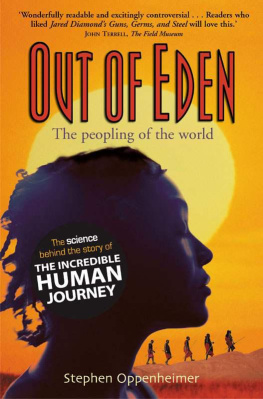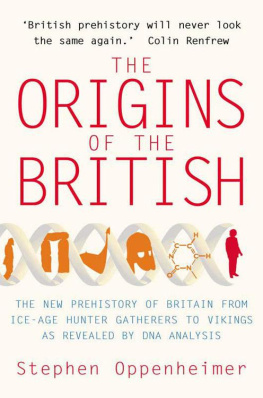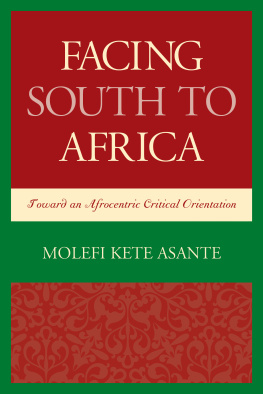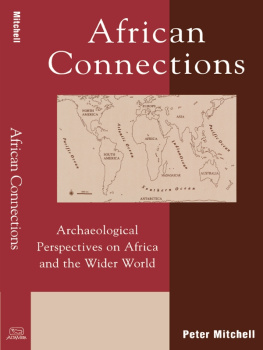S TEPHEN O PPENHEIMER is a world-recognized expert in the synthesis of DNA studies with archaeological and other evidence to track ancient migrations. He is a Research Associate at the Institute of Human Sciences, Oxford University.
Praise for Out of Eden
Wonderfully readable and excitingly controversial... Readers who liked Jared Diamonds Guns, Germs and Steel will love this.
John Terrell, Director of Anthropology,
The Field Museum, Chicago
To discover the real daughters of Eve, read on.
Martin Richards,
Researcher in Human Evolutionary Genetics
Readable but authoritative.
Andrew Sherratt, Professor of Archaeology,
University of Oxford
By the same author
Eden in the East:
The Drowned Continent of Southeast Asia
The peopling of the world
STEPHEN OPPENHEIMER
ROBINSON
London
Constable & Robinson Ltd
5556 Russell Square
London WC1B 4HP
www.constablerobinson.com
First published in the UK by Constable,
an imprint of Constable & Robinson Ltd 2003
This revised paperback edition published by Robinson,
an imprint of Constable & Robinson Ltd 2004
Copyright Stephen Oppenheimer 2003, 2004
The right of Stephen Oppenheimer to be identified as the author of this work has been asserted by him in accordance with the Copyright, Designs and Patents Act 1988
All rights reserved. This book is sold subject to the condition that it shall not, by way of trade or otherwise, be lent, re-sold, hired out or otherwise circulated in any form of binding or cover other than that in which it is published and without a similar condition including this condition being imposed on the subsequent purchaser.
A copy of the British Library Cataloguing in Publication Data is available from the British Library
ISBN 1841198943 (pbk)
ISBN 1841196975 (hbk)
eISBN 978-1-7803-3753-1
Printed and bound in the EU
1 3 5 7 9 10 8 6 4 2
Cover design: Simon Levy
Cover image: Getty Images
To my daughter Maylin and son David,
to my wife Freda,
and to my father and mother.
To know where we are going,
we have to know where we are;
to know that we have to know where we came from
Filipino version of an Oceanic proverb
C ONTENTS
I LLUSTRATIONS
Figures |
]) |
]) |
]) |
]) |
]) |
], after Clark 1969) |
]) |
]) |
], after Clark 1993) |
]) |
]) |
]) |
]) |
]) |
]) |
] and others) |
]) |
]) |
]) |
]) |
Plates |
A CKNOWLEDGEMENTS
S INCE PUBLICATION of the landmark Cann, Stoneking and Wilson out-of-Africa paper sixteen years ago, many in countries from all round the world have contributed to the understanding of our past through the growing gene trees of modern humans. These include the participants in the studies, lab staff, PhD students and post-docs right up to the heads of particular laboratories. As far as possible I have tried to give appropriate credit by citing relevant papers; but while refereed publications are scientists main visible research product, they depend not just on thorough, careful, hard work, but to some extent on that more fluid and transferable currency, original ideas. Ideas, like good tunes move from lip to lip sometimes hiding their origins. They are rarely explicitly credited and, in multi-author papers, the originator is sometimes difficult to deduce.
Work on mitochondrial DNA was pioneered in the US, during the late 1970s, by Wesley Brown and Douglas Wallace. The late Allan Wilson, the senior author on the 1987 Cann paper, is acknowledged by all to have been an inspiration to those who followed him. In this book I cite mainly papers from after that time. With the increasing pace of research during the 1990s and after the turn of the twenty-first Century, new people entered the scene. Without underplaying the work of many other groups and associates, I would like to identify what I regard as an inner circle of scientists who have pioneered the phylogeographic approach to tracing prehistoric human movements. Based in scattered parts of Europe, in some ways they are self-identified, since several other geneticists disagree with their methods. Among this inner circle are geneticists Martin Richards, Antonio Torroni, Silvana Santachiara-Benerecetti, Peter Forster and Toomas Kivisild working with Richard Villems. Their work was revolutionized by the mathematics required for the new tree-building. Again I would like to identify Hans-Jrgen Bandelt poly-math and mathematician and Vincent Macaulay physicist, statistician and mathematician, who did much to pioneer such methods and have both helped many teams including several, recently, from Russia and China. In a tensely competitive research field members of this group are surprising in the degree to which they all share their insights with each other.
The Y chromosome picture was pioneered initially by English geneticists from Leicester (Mark Jobling and Matt Hurles) and Oxford (Chris Tyler-Smith), but has subsequently been dominated by well-financed American laboratories with Peter Underhills (under Luca Cavalli Sforza) and Mike Hammers teams being the best examples. With large panels of gene markers, they have made extraordinary strides in bringing the Y-chromosome tree up to the same fine detail as that of mtDNA. Since mtDNA is relatively short there is a limit to what she can reveal and the Y chromosome will inevitably overtake her although dating will continue to be a problem. Lluis Quintana-Murci (now in Paris) made significant contributions to both the mitochondrial and Y chromosome stories.
When not expressing my own ideas and opinions, I have cited relevant papers that signaled a particular advance. Giving credit, where due, can be as important a function of the bibliography as that of showing the text-argument really is evidence-based. Popular genetics books without bibliographies run the risk of giving the reader the impression that the author worked it all out on his own. But citing publications is only one aspect of acknowledging my debts in compiling this book. While writing Out of Eden I have received an enormous amount of help directly from various people in terms of their time spent patiently explaining things to me, constructively criticizing my ideas, and offering their own insights. First and foremost is Martin Richards who, by good luck, I contacted when his own boss was unavailable a few years ago. Martin has given of his time unstintingly, including a critical reading of the book. He is, in my view, one of the main illuminati in this field. Next, in terms of hours on the phone and otherwise, is Vincent Macaulay followed by Hans Bandelt, Peter Forster, Toomas Kivisild and Chris Tyler-Smith. For the Malaysian Orang Asli genetic study, in addition to UK coauthors Catherine Hill, Martin Richards, William Meehan, James Blackburn, Mike Ward and Douglas Clarke, I would also like to thank our overseas collaborators, in particular Adi Taha without whose extraordinary efforts the study would have failed, Patima Ismail my Malaysian genetics collaborator, David Bulbeck who encouraged me to follow the route of his study, Muhamad Mahfuz Bin Nordin, and Norrulhuda Mohamad Halim, Norazila Kassim Shaari, Joseph Maripa Raja, Antonio Torroni, Chiara Rengo, Orang Asli participants, the JHEOA and, of course, Discovery Channel for financial support.
Next page








